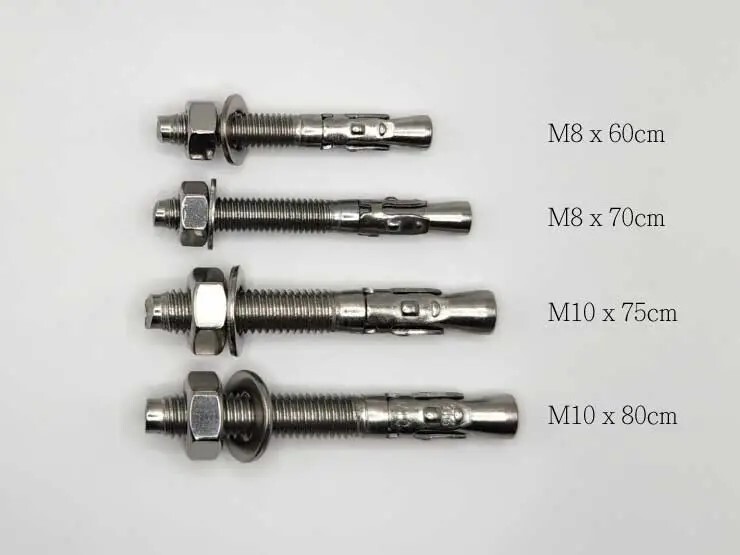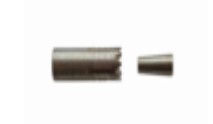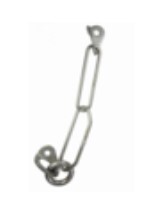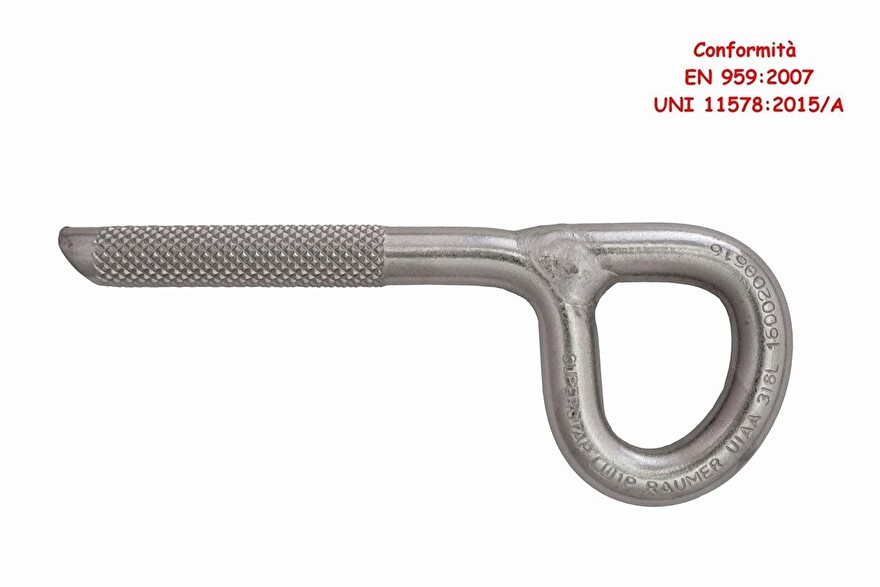Which anchors do you use for canyoning and caving?
In canyoning and caving, choosing the right anchors is crucial due to the challenging and often dangerous(er) conditions. Safety depends on using anchors that are suitable for wet, rocky and sometimes unstable surfaces. Here we list the most commonly used anchors and their properties for these sports:
Drilled and Bonded Anchors
- Glued Stainless Steel Anchors: Widely used in both canyoning and caving due to their durability and resistance to corrosion in wet environments. This type of anchor requires drilling a hole into which the anchor is bonded with a special chemical substance.
Adhesive anchors are durable under prolonged exposure to water and humid conditions. - Expansion Anchors (such as Drilled Anchors): This type of anchor, made of stainless steel or galvanized steel, is firmly clamped into the rock. Particularly useful for hard rock types, but less suitable for soft or porous rocks.
Through bolt Anchors / Parabolts
 Through bolt anchors / parabolts are a type of mechanical anchor that is widely used in climbing, caving, and canyoning to create secure attachment points in rocks / hard rock and concrete. Through bolt anchors / parabolts usually consist of a metal shaft with a screw head and an expansion sleeve at the end. When installing a through bolt anchor / parabolt, a hole is first drilled into the rock, into which the through bolt anchor parabolt is placed. When the bolt is tightened, the sleeve expands, anchoring the bolt firmly in the hole. Often used as temporary or semi-permanent attachment points.
Through bolt anchors / parabolts are a type of mechanical anchor that is widely used in climbing, caving, and canyoning to create secure attachment points in rocks / hard rock and concrete. Through bolt anchors / parabolts usually consist of a metal shaft with a screw head and an expansion sleeve at the end. When installing a through bolt anchor / parabolt, a hole is first drilled into the rock, into which the through bolt anchor parabolt is placed. When the bolt is tightened, the sleeve expands, anchoring the bolt firmly in the hole. Often used as temporary or semi-permanent attachment points.
Features and Benefits of Through bolt Anchors / Parabolts
- Strong Anchorage: provide a very strong and reliable attachment, especially in hard rock such as granite and limestone.
- Easy Installation: They can be installed relatively quickly without the use of chemicals, unlike adhesive anchors.
- Removability: are often easier to remove than bonded anchors, which can be useful for temporary routes.
- Suitable for Semi-Permanent Installations: are often used for semi-permanent routes as they can withstand high forces and are suitable for heavy loads.
Considerations when using through anchors / parabolts
- Rust and Corrosion: It is important to use stainless steel parabolts in wet or damp conditions (such as canyoning) to prevent corrosion.
- Surface: Parabolts work best in solid, non-porous rock. In soft or porous rock, parabolts may be less effective.
- Inspection: Regular inspection is important to check for wear and corrosion, especially if they are used in a permanent route.
Through bolt anchors / parabolts are a popular choice for adventure sports due to their strength and reliability. They provide climbers and cavers with a secure anchor point for descending, traversing and belaying.
Drop-in Anchors / Sleeve Anchors
 Are ideal for durable and strong fixings in hard materials and situations where fast and secure anchoring is required. Drop-in anchors are anchors that are hammered into a pre-drilled hole in the rock / concrete, after which they are firmly fixed and can be loaded immediately. They are often used for fixing structures to concrete or hard stone surfaces and are suitable for situations where you need a strong anchor without having to tighten the anchor, such as with mechanical expansion anchors (Through Anchors / Parabolts).
Are ideal for durable and strong fixings in hard materials and situations where fast and secure anchoring is required. Drop-in anchors are anchors that are hammered into a pre-drilled hole in the rock / concrete, after which they are firmly fixed and can be loaded immediately. They are often used for fixing structures to concrete or hard stone surfaces and are suitable for situations where you need a strong anchor without having to tighten the anchor, such as with mechanical expansion anchors (Through Anchors / Parabolts).
Applications of Drop-in Anchors
- Climbing and Industrial Security: For permanent climbing routes and belays in hard surfaces, drop-in anchors are often used as an alternative security. They are less suitable for damp and changing weather conditions and must be checked for corrosion if used outdoors.
- Concrete and Hard Stone Surfaces: Drop-in anchors are particularly effective in solid concrete or hard stone types, where they clamp firmly once hammered in. They are less suitable for soft or porous materials.
- Fastening Heavy Structures: Drop-in anchors are ideal for permanent fastening of heavy structures, such as steel structures, railings, and heavy machinery, because they have a high load-bearing capacity.
Considerations for Using Drop-in Anchors
- Immediate Load Capacity: Drop-in anchors can be loaded immediately after being driven in, making them useful for situations where quick work is required.
- Material Choice: Use stainless steel versions for outdoor conditions or humid environments to prevent corrosion.
- Non-Removable: Drop-in anchors are difficult to remove without damaging the material, making them suitable for permanent fastenings.
Using a Drop-In Anchor
- A drop-in anchor with a metric internal thread is suitable for fastening bolts and threaded rods. The drop-in anchor is suitable for temporary fixings, the sleeve sits nicely flat against the substrate and is therefore no longer in the way.
- Pre-positioned installation.
- Drive in the anchor using a hammer. Then use the correct size drop-in pin and drive in the cone of the anchor so that the plug can fully expand.
- The drop-in pin must sit completely against the edge of the anchor to ensure correct expansion.
Rings and Chains
 Rings: Stainless steel rings are popular because they provide a smooth surface for ropes to pass through, which is useful for canyoning. These anchors are often combined with expansion or glue anchors.
Rings: Stainless steel rings are popular because they provide a smooth surface for ropes to pass through, which is useful for canyoning. These anchors are often combined with expansion or glue anchors.
Chains: Chains are sometimes added to anchor points for added security and to maintain the correct direction of descent. Particularly useful in caving for difficult routes.
Glued Hooks or U-Bolts
 These are often used for permanent installations.
These are often used for permanent installations.
Chemical Anchor Hooks: These are sturdy hooks that, when glued, provide a secure place for descents and transitions.
U-Bolts are reliable and can accommodate multiple carabiners or ropes, which is useful in caving where multiple people need to descend.
Safety Considerations and Material Choice
- Stainless steel (SS) is the preferred material because of its resistance to rust, which is essential for canyoning due to the constant contact with water.
- Durability: In caving, anchors must withstand the pressure of heavy loads and often sharp, sometimes porous rocks.
- Maintenance and Inspection: For both canyoning and caving, it is important that anchors are regularly inspected for corrosion and wear. Anchors that are old or damaged can pose risks.
By using the right anchors and taking the environment into account, climbers and cavers can descend safely and follow their routes in challenging conditions.
Overview Knowledge base General canyoning and caving equipment : Go back.


